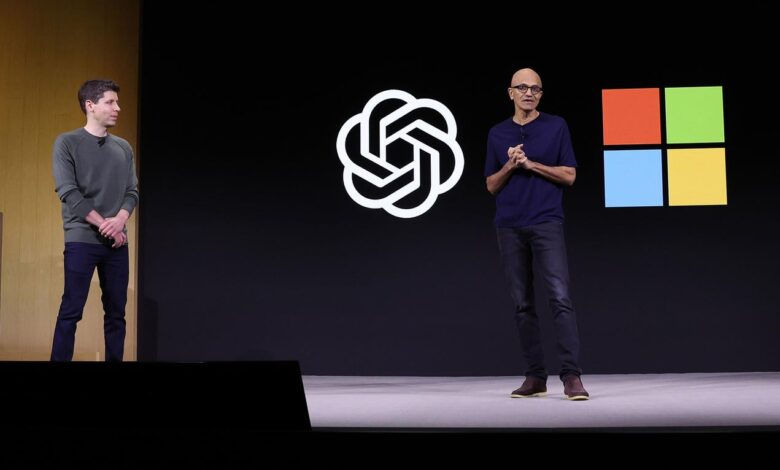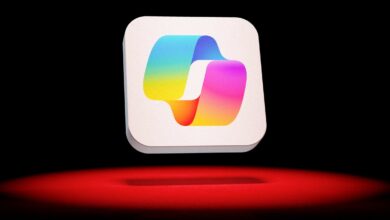Why Microsoft, OpenAI, And Apple Will Not Dominate Generative AI

SAN FRANCISCO, CALIFORNIA – NOVEMBER 06: Microsoft CEO Satya Nadella (R) speaks as OpenAI CEO Sam … [+]
As they race to dominate generative AI, tech giants and AI startups are simultaneously cooperating and competing.
OpenAI just partnered with Microsoft rival Apple. Microsoft — which invested many billions of dollars in OpenAI — has begun betting more heavily on the founder of Inflection, a rival large language model provider.
Which of these companies will end up dominating generative AI?
As their relationships evolve rapidly, I see Microsoft coming out ahead of Apple and OpenAI.
Yet, I do not see any of these taking the top spot. To make that assessment, I evaluated the companies on four tests:
- Is the company making money from selling generative AI products or services?
- If not, how does the company intend to monetize its generative AI investment?
- Does the company have industry-leading generative AI capabilities?
- If not, can the company build, partner or acquire the capabilities needed to provide an industry-leading product?
I think the current and future generative AI king is Nvidia — which as I noted in my new book Brain Rush — prevails on these four tests.
I have contacted Apple, OpenAI, and Microsoft for comment and will update this post if I receive a response.
Why Companies Seeking To Dominate Generative AI Can’t Go It Alone
It would be much easier for these players to get there without collaboration.
However, that is not possible because no one company excels at all the business activities needed — such as providing cloud services, building LLMs, designing powerful AI chips, and creating high-payoff generative application — to become the market-leading provider of AI chatbots.
For example, if Microsoft could build the best LLMs it would not have invested so much in OpenAI. Nor would the tech giant’s CEO Satya Nadella have rescued CEO Sam Altman last November after he was fired for week before being reinstated.
If the ChatGPT-maker had the capital to build its own computing systems to train and operate its LLMs, it would not need Microsoft. Nor would OpenAI have linked up with Apple to access the company’s 2.2 billion device users.
Such partnerships are temporary — waxing and waning as leaders recalculate what is in their company’s best interest.
After realizing how dependent Microsoft was on Altman, Nadella recruited Mustafa Suleyman, CEO of Inflection, an OpenAI rival, to build a separate LLM, the Wall Street Journal reported.
Not to be outdone, on June 10 Open AI and Microsoft rival, Apple, announced their partnership. One analyst said Nadella would not be happy with this deal. “It has to be a sinking feeling after all that he’s done for OpenAI,” Gene Munster, managing partner at Deepwater Asset Management, told the Journal.
Since it does not shift OpenAI to a new cloud partner, the OpenAI/Apple deal does not look to me like a significant threat to Microsoft. This collaboration merely makes ChatGPT an option for users to answer questions Apple’s AI cannot, according to my June 11 Forbes post.
Microsoft could be moving to lessen its dependence on OpenAI.
How so? “Some future Microsoft AI products could be switched from OpenAI technology to the model being developed by Suleyman’s team,” the Journal noted — citing an anonymous source.
Investors responded to Apple’s AI strategy by boosting the iPhone maker’s stock market capitalization to $3.27 trillion on June 12 — briefly surpassing Microsoft’s which ended the day at $3.28 billion.
Microsoft and OpenAI could become more competitors than collaborators. How so? Altman — who in February sought to raise “up to $7 trillion” in capital, the Journal reported — appears eager to free OpenAI from its dependence on Microsoft.
And Nadella’s efforts to build its own AI models suggests OpenAI — now valued at $86 billion, according to the Journal — could end up in Microsoft’s rear view mirror.
Microsoft Has Potential To Strengthen Its Generative AI Capabilities
Microsoft has aggressively pursued investments, partnerships, and acquisitions to get a foothold in generative AI. Notable moves include:
- Investing $13 billion in OpenAI — most of which goes to paying for OpenAI’s use of Microsoft’s cloud services, I noted in my June 11 Forbes post.
- Hiring most of Inflection’s team — including Suleyman.
- Providing capital to “a range of AI startups, including pouring $1.5 billion into an Abu Dhabi-based firm in April,” wrote the Journal.
- Building consumer-facing AI chatbots — dubbed Copilots, about which I wrote in an October 2023 Forbes post.
Microsoft gets a mixed score on my four tests. The giant company excels in cloud services and seems to have the potential to monetize its generative AI investments. Yet Microsoft seems to be struggling to master the skills needed to build LLMs and to deliver an AI chatbot users consider worth the price.
Here is my assessment of Microsoft’s performance on my four tests:
- Is the company making money from selling generative AI products or services? The company’s financial reports do not break out such products or services. Yet Microsoft offers vague estimate of how much generative AI contributes to growth in the company’s Azure cloud services line. For example, “more than a fifth” of Azure’s 31% growth in the first three months of 2024 came from generative AI, noted the New York Times. The software giant did not share revenue from $30 per user-month Copilot subscriptions.
- If not, how does the company intend to monetize its generative AI investment? Microsoft envisions generative AI and Copilot subscriptions adding to the company’s revenues in the future. Copilot could add $30 billion to Microsoft’s top line, according to my October post.
- Does the company have industry-leading generative AI capabilities? Microsoft’s cloud services are among the industry’s best. The company spent $14 billion on capital expenses and leases in the first three months of the year — much of it for global data centers, noted the Times.
- If not, can the company build, partner or acquire the capabilities needed to provide an industry-leading product? As outlined above, Microsoft is trying to build, partner and acquire industry-leading generative AI capabilities such as building LLMs and offering generative AI-powered services for end-users. Many companies are still questioning whether Copilot is worth the extra money, I noted in Brain Rush.
OpenAI
OpenAI lit the generative AI firestorm after ChatGPT reached 100 million users between its November 2022 launch and January 2023. ChatGPT users have since grown at a relatively slow 46% annual rate to 180.5 million by June 2024, according to NamePepper. Meanwhile, OpenAI’s private market value has increased from a few billion in October 2022 t0 $86 billion in January 2024, according to PitchBook.
OpenAI is doing well at generating AI revenue, building and operating LLMs, and offering services for which users are willing to pay. OpenAI depends on other companies for cloud-services and access to handheld devices.
Here is my assessment of OpenAI on the tests I outlined above.
- Generative AI products or services revenue: The company has a clear generative AI business model from licensing its software. OpenAI’s revenue totaled $2 billion in 2023 and is forecast to rise 70% to $3.4 billion by the end of 2024, according to PitchBook.
- Industry-leading generative AI capabilities: ChatGPT’s LLM is the industry leader. As of June 2023, ChatGPT accounts for “60% of monthly web traffic to the top 50 most used generative AI web products,” according to Backlinko, which noted “No other paid AI tool had more than 5.2% market share.”
- Building, partnering or acquiring generative AI capabilities: OpenAI has partnered with Microsoft to get access to the cloud services needed to train and operate ChatGPT. That partnership seems to be working well. It remains to be seen whether OpenAI’s deal with Apple will be similarly successful.
Apple
Apple has been late to the generative AI game. That is nothing new for Apple. Apple arrived late to PCs, MP3 players, cell phones, and tablets among other products and ended up building very successful products. The most notable has been the iPhone — now a 17 year old product, as I wrote June 11.
Yet, when it comes to introducing new fast-growing products, Apple under the leadership of Steve Jobs is not the same as it has been since 2011 under Tim Cook. That is evidenced by the latest quarter’s 10% drop in iPhone revenue and the 4% drop in the company’s total revenue.
To the challenge of dominating generative AI, Apple brings a mixture of strengths — such as its large user base which trusts the company’s privacy protections and security — and opportunities for improvement — in hiring and motivating leading AI talent and offering cutting edge AI chatbots.
Here is my assessment of Apple on these four tests:
- Generative AI products or services revenue: Apple has no current revenue directly related to generative AI products or services.
- Potential generative AI business model. It is unclear whether Apple will charge users extra money for generative AI services — which range from an upgraded version of Siri to extracting information from, say, a driver’s license photo and using it to fill out a credit card application. Perhaps Apple expects Apple Intelligence to result in more iPhone revenue. Analysts expect these generative AI services to lower iPhone revenue in the short-term, I noted June 11.
- Industry-leading generative AI capabilities: Apple has access to many loyal users of its handheld devices along with a reputation for caring about the privacy and security of user information. With 2.2 billion devices being used by people around the world, Apple is a leader in potentially easing access to generative AI for a significant number of people.
- Building, partnering or acquiring generative AI capabilities: Apple has already developed its own AI capabilities which it plans to offer consumers in a more conversational version of Siri. The company has struggled to attract and return top AI talent, the New York Times reported. Users will have the option of tapping into ChatGPT if they are not satisfied with Apple’s AI. Apple is also building its own private cloud service and designing its own chips.
Nvidia
Since November 2022, Nvidia’s stock has soared 770%. During that time, Microsoft shares increased 93% while Apple’s stock increased 48%, as I wrote June 11.
Nvidia has significant revenue from selling GPU chips used to train and run LLMs — most of its $26 billion in revenue in the April-ending quarter — a 262% increase from the previous year — came from selling such GPUs, noted Forbes.
The chip designer is rapidly introducing new chips to stay ahead of its rivals. Moreover, Jensen Huang, Nvidia’s CEO is a highly talented leader who could keep the company ahead of the pack for years, according to my June 10 Forbes post.
Nvidia could be a better bet on generative AI than Microsoft or Apple.



